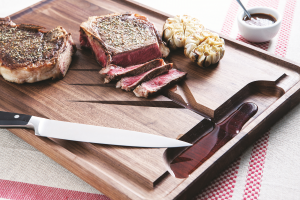Between Blocks and Boards
By Micah Cheek
 When I met Kristine McCutcheon from Larch Wood Enterprises, I spoke without thinking. I asked, “Can you talk to me a little bit about these cutting boards?” McCutcheon was quick with the response. “These aren’t cutting boards, they’re butcher blocks.” Lots of consumers treat butcher blocks and cutting boards as synonyms, but differences in grain, thickness and structure can inform what a board can handle. “They have different structures for different purposes. Boards are for serving and blocks are for cutting,” McCutcheon added. She went on to explain how different types of boards are designed for different tasks.
When I met Kristine McCutcheon from Larch Wood Enterprises, I spoke without thinking. I asked, “Can you talk to me a little bit about these cutting boards?” McCutcheon was quick with the response. “These aren’t cutting boards, they’re butcher blocks.” Lots of consumers treat butcher blocks and cutting boards as synonyms, but differences in grain, thickness and structure can inform what a board can handle. “They have different structures for different purposes. Boards are for serving and blocks are for cutting,” McCutcheon added. She went on to explain how different types of boards are designed for different tasks.
Traditionally, butcher blocks are made with end grains. An end grain faces towards the top of the board rather than along its length. Wood is made of individual fibers, and when the end grain is facing up, all of those fibers are standing vertically. On the molecular level, the knife’s edge cuts between these filaments rather than across them. This can be demonstrated with spaghetti. If you have some dry spaghetti standing vertically, and some lying down horizontally, it’s easier to put a knife through the vertical strands, because the knife moves between them rather than having to cut through. Over time, this means fewer deep cuts and grooves in the board’s surface, as the wood fibers close up around knife incisions. Many butcher blocks are also thicker, to insulate against the impact of a knife. Some boards, like the Traditional Butcher Blocks from John Boos, can measure 10 inches thick and come equipped with legs to stand on.
While the butcher block is designed for heavy chopping and fabricating, cutting and serving boards are made for more gentle use. Cutting boards are usually made with the grain going lengthwise, rather than up and down. This makes for a harder surface to cut on, but highlights beautiful long lines along the wood grain. These boards also tend to be thinner than butcher blocks and light enough to carry to the table. As this build requires less cutting and fabricating, edge grain boards tend to be less expensive as well.
Two seasons ago, JK Adams redesigned its butcher blocks with features to make it easier to navigate around the kitchen. “On our end grain boards, we tried to add more features. [We added] silicone feet to protect countertops, juice grooves, and handles or undercuts that allow someone to move or carry them around a little easier,” says Jon Blatchford, CEO of JK Adams. These changes further blur the line between blocks and boards, making a block that is easy to carry, which makes it easy to serve on. There is some discussion on how grain alignment can affect a knife’s blade over time, but Blatchford notes that for knife edges, the grain orientation matters less than the material itself. “Hardwood is the key,” he notes. “[Compared to] plastic, bamboo or synthetic materials, hardwood tends to be the best on a knife blade and is the most sanitary.”
The care and maintenance regimens for cutting boards and butcher blocks are very similar. In addition to hand washing and immediate towel drying, all wood boards need to be conditioned with mineral oil or a food-safe, wax-based wood conditioner. “The more you oil them, the better they’re going to be,” says Blatchford. “You’re truly making an investment that you’re going to only make one time if you treat them well.”

You must be logged in to post a comment.